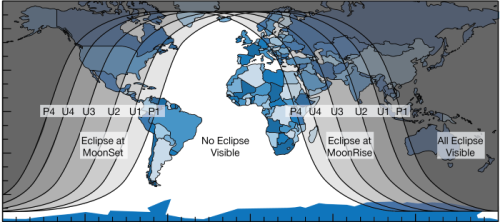
Eclipse watching: where the blood moon will be visible (Courtesy: NASA)
By Hamish Johnston
Tomorrow, people around much of the world should be able to see a lunar triple-whammy. There are two full moons this month, which is a relatively rare occurrence called a blue moon. The Moon is also near its closest approach to Earth, which means that it will loom large in the sky as a super moon.
And it just so happens that the Earth will pass between the Sun and the Moon tomorrow, causing the lunar surface to darken in a total lunar eclipse. When this happens, some red light from the Sun manages to refract around the Earth and strike the Moon – giving it a blood red appearance.
While the eclipse will be visible across much of the world, people in western Europe and huge swathes of South America and Africa will miss out because it will be daytime there (see figure).
If you are unlucky and can’t see the super blue blood moon eclipse, NASA TV will be broadcasting observations live from telescopes at NASA’s Armstrong Flight Research Center in Edwards, California; Griffith Observatory in Los Angeles; and the University of Arizona’s Mount Lemmon SkyCenter Observatory. The show starts at 10:30 UTC on 31 January.
Guidelines
Show/hide formatting guidelines
this text was deletedwhere people live in harmony with nature and animals</q>
Some text